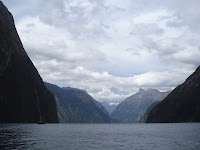For years bird researchers from the Miranda Shorebird Center in New Zealand and the Alaska-based US Geological Survey team believed that the Bar-tailed Godwit flew non-stop from Alaska to New Zealand on their Fall southern migration. Many peers didn't believe that this 40-cm long bird couldn't possibly fly the 11,500 km needed to complete the journey, especially as a non-stop flight would indicate no sleep, no food and no water over that time. Last year, however, for the first time in history, satellite transmitters revealed the truth, making those researcher's hypotheses a reality.


The Bar-tailed Godwits (left) at Miranda get pushed into these pools on high tide. We set up mist nets that the birds will fly into when landing there to roost.
Last year, one bird's battery lasted her entire migration, tracking her flight from New Zealand up through Yalu Jiang, China and then up to Alaska on her Spring northern migration. After breeding, the battery then lasted her entire southern migration, non-stop for 8 days and nights from Alaska to New Zealand. Her flag on her leg identifies her as 'E7', and following the tracking of her 29,000 km migration, she has now made news headlines as far off as Tehran. With that success in the bank, this year's project saw 9 birds implanted at Miranda, and a further 16 done in Broome, northwestern Australia.
After catching the birds in the nets we set up (left), we put them in boxes and either banded and released them on the spot, or took them back to the Center for implanting and flagging.
Having to wait for an after-sunset tide (therefore making the black mist nets difficult to see for the birds) put us in the position of kneeling beside the ponds waiting for the high tide on the nearby shoreline to push them our way. Hearing the birds whooshing over our heads in the cover of darkness was quite the experience. The more experienced researchers then removed them from the nets and placed them in special boxes, which we then took to a nearby van where they were measured. If they were big, healthy and already fattening up, they were kept as candidates for implanting and put aside. All the others, 40 or so, were banded there and then released. After 25 minutes or so, we had our candidates and it was back to the Center, a 2-km drive away, for the important part of the whole operation - the surgical implants of the transmitters themselves.


The largest birds were implanted with satellite transmitters (left), a procedure which sees them put under for 30 minutes. The rest, about 50 this time, are flagged and banded (left).
An Alaskan vet from the USGS team joined a New Zealand vet for the operations, during which the birds are put under for 30 minutes. The transmitter, the size of a date with a trailing black antennae (seen above, right) is implanted into an air sac in the bird's side. After they come to, they're flagged with black flags with white alpha-numeric lettering. Seeing these birds on the table really brought home how fragile these birds are, but also how resilient they are too. One hour after the procedure, they were brought back to the shoreline and released, ready to fatten up even more before heading north in two weeks.
The rest of the birds were measured, banded and flagged with a white flag (denoting New Zealand) with 3 capital letters on them. Now, when someone spots these flags up and down the flyway, they're an email away from knowing when and where the bird was banded, and another piece of these birds lives is filled in. Being a part of this team, which numbered 24 people, was an experience neither of us will forget. It was not only exciting holding the birds in our hands and seeing experienced people go to work, but also knowing that this project is using the latest technology to chart new pathways in the way we understand birds, and therefore, understand the world around us.
Giving signals for 6 hours and then going offline for 36, the bird's transmitter will create 'blips' on a screen, which can then be connected to show their flight path. A web page connected to Google Earth will be set up soon so we can track these birds as they begin their incredible 29,000 km migration, continuing what that species has done for thousands of years, but which we have only proven without doubt for 2 years. We will put the link on our blog when it's created. Now only time will tell to see if last year's incredible success can be repeated.











